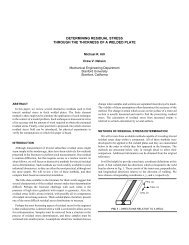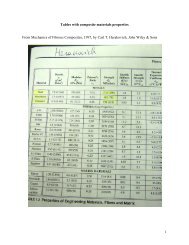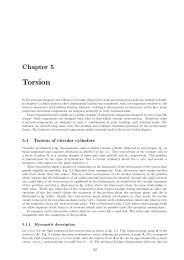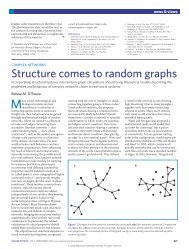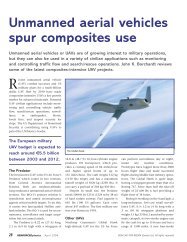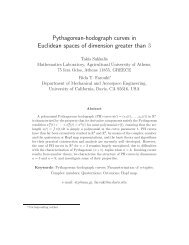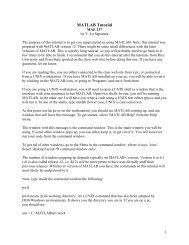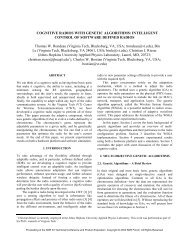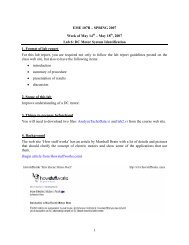A Simplified Eigenstrain Approach - Department of Mechanical and ...
A Simplified Eigenstrain Approach - Department of Mechanical and ...
A Simplified Eigenstrain Approach - Department of Mechanical and ...
You also want an ePaper? Increase the reach of your titles
YUMPU automatically turns print PDFs into web optimized ePapers that Google loves.
4<br />
removing the region <strong>of</strong> interest from the slice. This modified sectioning process allows for<br />
separation <strong>of</strong> the eigenstrain field into two portions, one lying inside <strong>and</strong> one outside <strong>of</strong> the<br />
region <strong>of</strong> interest.<br />
Figure 5 – Pictorial representation <strong>of</strong> the localized<br />
eigenstrain technique for continuous welds.<br />
The localized eigenstrain method is most easily described with a specific geometry,<br />
sectioning plan, <strong>and</strong> strain measurement scheme in mind. Assume that a block <strong>of</strong> material has<br />
been removed from a welded joint <strong>and</strong> has dimensions shown in Figure 6(a). A region <strong>of</strong> interest<br />
in the xy-plane<br />
<strong>of</strong> this block is identified, shown shaded in the figure. The free surface <strong>of</strong> this<br />
region is instrumented as shown in Figure 7. Following instrumentation, the block is sectioned as<br />
shown schematically in Figure 5 with dimensions <strong>of</strong> the slice <strong>and</strong> chunk shown in Figure 6(b)<br />
<strong>and</strong> (c). Strain changes are measured that accompany removal <strong>of</strong> the slice from the block,<br />
removal <strong>of</strong> the chunk from the slice, <strong>and</strong> finally cutting the slice into dice. Assuming that the dice<br />
are small enough relative to the spatial gradients <strong>of</strong> eigenstrain, the dice will be stress-free. Using<br />
relaxation data with elastic stress-strain relations for plane stress, residual stress can then be<br />
computed at the free-surface measurement sites on the block, slice, <strong>and</strong> chunk geometries. The<br />
localized eigenstrain method then uses these reduced stress data to estimate the eigenstrain<br />
distribution which, in turn, allows stress to be computed at any point in the region <strong>of</strong> interest.<br />
2.1 Division <strong>of</strong> eigenstrain into<br />
ε*<br />
A <strong>and</strong> ε*<br />
B<br />
Figure 6 – (a) Block <strong>of</strong> material removed from a<br />
welded joint, (b) slice removed from the block, <strong>and</strong><br />
(c) chunk removed from the slice. The chunk would<br />
further be sectioned into dice.<br />
One <strong>of</strong> the crucial steps in assuring success <strong>of</strong> the localized eigenstrain method is separation<br />
<strong>of</strong> the eigenstrain into two parts. The first part, ε* B , is found from stress in the chunk, <strong>and</strong> the<br />
second part, ε* A , from stress in the slice. This second part <strong>of</strong> the eigenstrain is further divided<br />
into two distinct parts. The first is eigenstrain which lies within the region <strong>of</strong> the chunk, but does<br />
not cause stress once the chunk is cut free from the slice. The second part <strong>of</strong> ε* A<br />
is an<br />
approximate representation for eigenstrain which lies outside <strong>of</strong> the chunk region. To correctly<br />
account for this division, the x-interpolation<br />
for each portion <strong>of</strong> the eigenstrain has been carefully<br />
developed (Hill, 1996b). The y-interpolation,<br />
on the other h<strong>and</strong>, is a simple linear interpolation<br />
with seven equally spaced nodes.<br />
T<br />
z<br />
W = 203mm<br />
T = 38mm<br />
D = 127mm<br />
B = 0.8T<br />
y<br />
x<br />
B<br />
W<br />
T<br />
3B<br />
B<br />
D/20<br />
D<br />
D/20<br />
(a)<br />
(b)<br />
(c)





